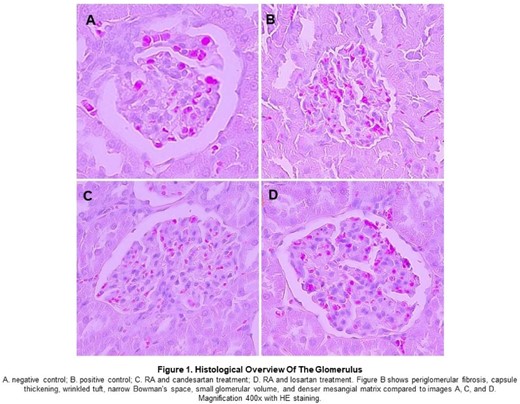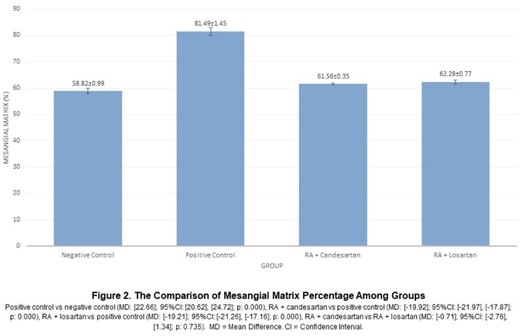-
PDF
- Split View
-
Views
-
Cite
Cite
Pandu Tridana Sakti, Nur Samsu, Achmad Rifai, #5018 EFFECTS OF CANDESARTAN COMPARED TO LOSARTAN ON INHIBITING MESANGIAL EXPANSION IN DIABETIC MODEL RATS RECEIVING ROSMARINIC ACID, Nephrology Dialysis Transplantation, Volume 38, Issue Supplement_1, June 2023, gfad063d_5018, https://doi.org/10.1093/ndt/gfad063d_5018
Close - Share Icon Share
Abstract
Oxidative stress and activation of the renin-angiotensin system (RAS) due to chronic hyperglycemia are the pathogenesis of diabetic nephropathy (DN). Until now, therapy for DN has not shown satisfactory results. Rosmarinic acid (RA) which has antioxidant, anti-inflammatory, anti-fibrosis effects, and ARB which can inhibit RAS activation may have a synergistic effect to prevent DN progression. This study aims to determine the effect of inhibiting mesangial expansion in diabetic rat models after being given a combination of RA and ARB (candesartan or losartan).
True experimental laboratory trial with randomized post-test only control group method on Rattus norvegicus strain Wistar rats. Diabetic rats were prepared by giving a high-fat diet (60% fat calories) and a single injection of 40 mg/kg streptozotocin. Mice were divided into 4 groups, each consisting of 4 rats: negative control (healthy rats); positive control (placebo diabetic rats); diabetic rats that received RA and candesartan; diabetic rats that received RA and losartan. The rat glomerulus was evaluated to assess mesangial expansion using ImageJ 1.48 software after 8 weeks of treatment by a pathologist blindly. Data analysis with One-way ANOVA and Tukey's post hoc tests.
The results of the percentage of the mesangial matrix in the positive control group (81.49% ± 1.45) were higher than the negative control group (58.82% ± 0.99). The results of the percentage of the mesangial matrix in the RA + candesartan treatment group (61.56% ± 0.35) and the RA + losartan treatment group (62.28% ± 0.77) showed lower results than the positive control group, with the One-way ANOVA test results showing significant differences (p: 0.000). Tukey's post hoc tests showed the positive control group that received a high-fat diet and induced diabetes with STZ significantly increased mesangial expansion compared to negative control (MD: [22.66]; 95% CI: [20.62], [24.72]; p: 0.000). The RA + candesartan treatment group significantly inhibited mesangial expansion compared to the positive control (MD: [-19.92]; 95% CI: [-21.97], [-17.87]; p: 0.000), as well as the RA + losartan treatment group (MD: [-19.21]; 95%CI: [-21.26], [-17.16]; p: 0.000). The RA + candesartan treatment group showed a better effect in inhibiting mesangial expansion compared to the RA + losartan treatment group, but not significantly (p: 0.735).
The combination of rosmarinic acid with candesartan or losartan has the effect of inhibiting mesangial expansion in diabetic rats.


- anti-inflammatory agents
- antioxidants
- oxidative stress
- losartan
- renin-angiotensin system
- diabetes mellitus
- diabetic nephropathy
- calories
- fibrosis
- kidney glomerulus
- rats, wistar
- software
- streptozocin
- mice
- rats
- candesartan cilexetil
- chronic hyperglycemia
- laboratory test finding
- positive control
- medical pathologists
- diet, high-fat
- data analysis





Comments